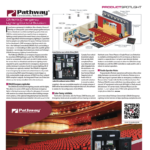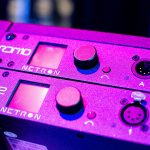In mid 2017, d3 Technologies revealed its newest and fastest range of servers to date, the gx range. With two models, the gx 1 and gx 2, the new systems meet the increasing demand for real-time generative effects, and then some. Let’s take a closer look at some of its impressive features.

First Impressions
From the time you open the box, it’s obvious that the gx 1 and gx 2 mean business. Both have been streamlined in the effort to increase performance. Both have the same processing power. In fact, most of the main differences between the two are in the number of outputs. For shows that require up to 8 HD or 2x 4K outputs, the 4U gx 2 is the one to choose. For smaller shows or applications that don’t require more than one 4K or four HD outputs, the 2U gx 1 fits in nicely.

Hardware Highlights
Both models feature a Xeon Quad-Core 3.7Ghz CPU, 16 Gigabyte DDR4 RAM, an internal System/Restore Drive and a 2TB NVMe drive for content storage. There’s also Genlock and support for d3’s swappable VFC cards that come in three flavors: 1x DisplayPort, 4x DVI and 4x SDI.
For video inputs, the gx 1 has three HD-SDI or two 3G-SDI, while the gx 2 has four HD-SDI or two 3G-SDI. And, with the release of r14.3 software, the gx 2 is also capable of 4K capture.
The gx 1 has one balanced XLR audio input for timecode, while the gx 2 has two balanced inputs and two balanced outputs, one mini jack for headphones and ADAT/SPDIF digital audio input/outputs.
Last but not least, both the gx 1 and gx 2 have two Gigabit and two 10Gigabit ports.

GPU
What makes the gx range the fastest tool for creating real-time interactive effects? The gx 2 is built around one of the most powerful professional grade GPUs available, the GP102, used in the NVidia Quadro P6000, and the gx 1 is based on the GP104 used in the P4000.
Both of these pack a lot of horsepower. As electronics manufacturing leader PNY Technologies states, “the NVIDIA Quadro P6000 is the most advanced pure professional graphics solution ever created, combining the latest GPU, memory and display technologies that result in unprecedented performance and breakthrough
capabilities.”
Both models also use NVidia’s Quadro Sync II technology to genlock all outputs on each VFC (Video Format Conversion) card, enabling the playback of high-resolution content across multiple outputs with no dropped frames and near-zero latency.

Stress Testing
After launching a new project and adding a few layers on the timeline, I decided to set up my own unscientific stress test on a gx 2 to see if I could make the machine squeal a little. What I discovered was that I would have to do some very purposeful (and very unattractive) layer manipulations that would be very unlikely in the real world in order to even get the gx 2 to bat an eye.
For instance, I started out by simply playing back eight layers of HD content. The built in FPS monitor graph stayed locked on 60FPS, not even a twitch. Then I copied those same layers and added visual effects (not Notch FX at first). Still, 60FPS.
So then I found some free 4K content online and created eight 4K LED screens, created eight Layers, and added visual FX to each. Only a frame dropped here and there, nothing worth noting.
Then I started manipulating layer attributes like playback speeds, playback directions, visual effects settings, and I even added a Notch effect to three or four layers.
Finally, I was able to see the machine move off the 60FPS line, hovering between 30-40FPS. But not without a lot of purposeful experimenting, trial and error, and some very silly composites.
So, to borrow a line from a famous movie critic, I can say that I give it two thumbs up for playback performance. (I did say it wasn’t scientific.)

Notch
The gx models also have a very nice bonus: they come with a two-year Notch playback license already installed. Haven’t heard of Notch? Notch is a third party generative content creation tool that is catching on like wildfire in the generative content world.
Notch’s strength comes from the GPU’s power, and it is used to create, simulate, render, composite, edit and play back in real-time. And the possibilities of what can be created with it are endless.
Combine that with the GPU power of the gx models, add in the ability to communicate with externally created data (like truss motors or tracking cameras), and practically any concept is possible.
Also worth noting: d3 has Gold support for Notch real-time generative effects playback. They also include a library of sample effects to get you started including: Color Correction/ Grading, Distortion, Edge Detect, Edge Ghosting, Fish Eye, Glitter, Glow, Rain, Ripples, Scanlines, Snow, Sparks and VHS.
You can also download some other free ones from Notch’s website: notch.one/products/notch-blocks. (Just be sure to download the 64bit versions.)
The Bottom Line
With MSRPs that range from $45K-$85K, these latest tools from d3 Technologies are clearly positioned for the professional market. But if you’re looking for servers that can handle 4K content, real-time effects and play it all back without breaking a sweat, the gx 1 and gx 2 are the servers for you.
At a Glance
Tools for a New World of Digital Content
The gx range was built primarily to meet the demands of the growing need for real-time generative and interactive content used in events of all kinds. Whether the show involves the use of real-time data like automation, sensor-tracking feedback for interactivity with video, playback of audio, and/or event triggering via MIDI or OSC, gx users are better able to create immersive, 3D worlds than ever before.
d3 gx 1 and gx 2
- PROS: Currently the fastest tools for creating real-time interactive effects. These systems can process ridiculous amounts of digital content without breaking a sweat.
- CONS: None
SPECS:
gx 1 and gx 2:
- CPU: Xeon Quad-Core 3.7Ghz
- Memory: 16GB DDR4 RAM
- Storage: 2x 80GB SSD, 2TB SSD
- OS: Windows 10 IoT Enterprise LTSB
gx 1:
- Video Output: 1x DisplayPort 1.2 (Stage) (4096 x 2160 max); 1x DisplayPort 1.2 (GUI); Different VFC cards available
- MSRP: $45K
gx 2:
- Video Output: 2x DisplayPort 1.2 (Stage) (4096 x 2160 max); 1x DisplayPort 1.2 (GUI); Different VFC cards available
- MSRP: $85K
Manufacturer: d3 Technologies
More Info: www.d3technologies.com , www.plsn.me/d3-gx


